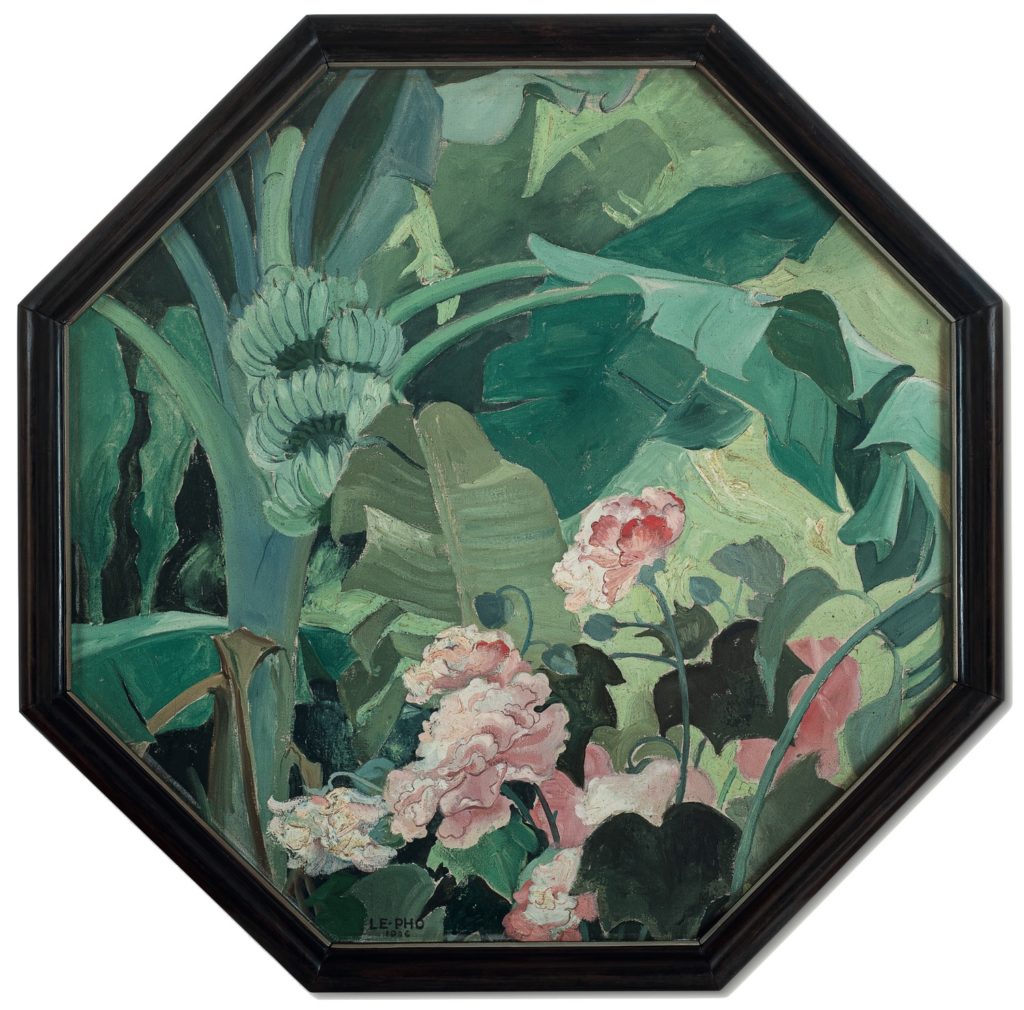Le Pho, « l’adieu au Tonkin », 1936, or the window, mirror of memory
“Farewell to Tonkin” is an essential work by Le Pho.

Its symbolic form, unique in the painter’s work, the particular context in which it was created, the remarkable depiction, and the personal but linked destinies of the Tholance-Lorenzi couple (Orsolla née Guglielmi (1888-1968) and her husband Auguste Tholance (1878-1938)) and Le Pho all contribute to the work’s special aura.
We know that the collection of Auguste Tholance, the former Superior Resident of Tonkin, and his wife Orsolla Lorenzi, created very early on, brought together a magnificent group of works by various artists from the Hanoi School of Fine Arts, including Nguyen Phan Chanh, Nguyen Tuong Lan, Lé Yèn… and others, all chosen at the source, with exquisite taste and profound erudition. A collection marked by a shared passion for Vietnamese art.
Their quasi-familial relationship with Le Pho, orphaned at an early age, enabled them to acquire some of his masterpieces. Several of these have been – “Femme assise”, a silk painted in 1934 or “La vue du haut de la colline”, an oil on canvas from 1937 . Let’s also mention the large lacquer screen “Paysage du Tonkin” dated 1937, featured in the exhibition “Paraventi: Folding Screens from the 17th to 21st Centuries” (October 26, 2023-February 26, 2024) at the Prada Foundation in Milan.
In 1936, two departures from Vietnam were scheduled. One for the Tholance-Lorenzi family, who were returning to “metropolitan France” after a very long stay in Vietnam, the other for Le Pho, who already knew that he would be Director of the Indochina art section at the Paris Universal Exhibition the following year. Le Pho also realized after his trip to China in 1934 that his work would remain in the realm of “Western” research, and that the ready-made career offered to him as a teacher at the Hanoi School of Fine Arts would not satisfy him.
A drastic change in life for the couple and for the painter, who was preparing his second trip to France after his first experience in 1931-32.
Was he already aware that he would never return to his homeland, and that he would spend more than two times of his entire life in France than in Vietnam?
It is in this context of shared and probably bijective emotion that the work is born. Was it a commission or a gift? We don’t know.
What’s immediately obvious is that Le Pho, fond of symbolic quotations, accompanies his work with an octagonal solid wood frame proud of its 8 auspicious ridges.
The frame is in the shape of a window looking out on a landscape of pure nature.
A simple vision. No figures, no buildings, not even a fence or a bird. Flowers and a fruit tree amid a mass of leaves in a cameo of green. A luxuriant vegetation.
The land of Vietnam.
And its nourishing beauty.
The banana tree and its nourishing, symbolic fruit, ceremoniously offered on altars as a wish for academic and professional success.
Its clustered growth symbolizes family unity and its yellow color, that of happiness.
Accompanying this luxuriance of green – lightened on the right-hand side as if by a streak of sunlight – is the peony, queen of flowers after the lotus. A symbol of beauty, distinction and prosperity.
The painter arranges his scene with strong, flat brushstrokes, reserving lighter touches for the flowers.
His signature in Roman letters is rarely accompanied by the usual two Chinese characters. Reaffirmation of a modern Vietnamese identity?
What Le Pho wants to remember for himself and the Tholance-Lorenzi family is this beautiful, fresh nature, these heady scents that delight the senses. He knew that the lucky recipients of his painting would only have to direct their gaze towards it to recall their beloved Tonkin. In fact, the painting never left the walls of his Nice apartment, where Orsolla – Auguste died in 1938 – contemplated it, sometimes with Le Pho at his side, every day until his death in 1968.
On Orsolla’s death, it was given to a family member as a token of their shared love of Vietnam.
This window, mirror of memory.
Jean-François Hubert